It’s a question we get all the time.
Watch the sky closely in the dawn or dusk hours, and you’ll likely see a moving “star” or two sliding by. These are satellites, or “artificial moons” placed in low Earth orbit. These shine via reflected sunlight as they pass hundreds of kilometres overhead.
Many folks are unaware that you can see satellites with the naked eye. I always make an effort to watch for these during public star parties and point them out. A bright pass of the International Space Station if often as memorable as anything that can be seen through the eyepiece. But after this revelation, “the question” soon follows- “What satellite is that?”
Welcome to the wonderful and highly addictive world of satellite tracking. Ground observers have been watching the skies since Sputnik 1 and the first satellite launch in October 1957. Armies of dedicated volunteers even participated in tracking the early launches of the Space Age with Operation Moonwatch.
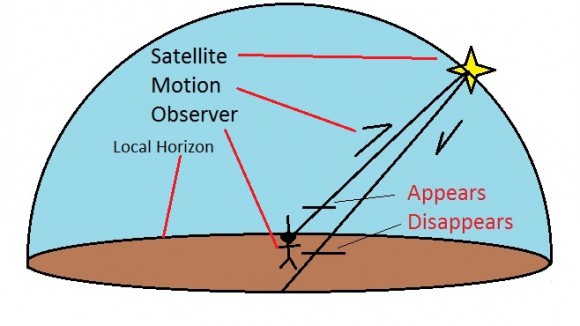
The Internet has offered a wealth of information for satellite hunters. Every time I write about “how to spot the ISS,” someone amazes me with yet another new tracker App that I hadn’t heard of. One of my favorites is still Heavens-Above. It’s strange to think that we’ve been visiting this outstanding website daily for a decade and a half now. Heavens-Above specializes in satellites, and will show you a quick listing of passes for brighter satellites once configured with your location. A nifty “quick check” for possibly resolving a mystery satellite is their link for “Daily Predictions for brighter satellites” Which will generate a list of visible passes by time.
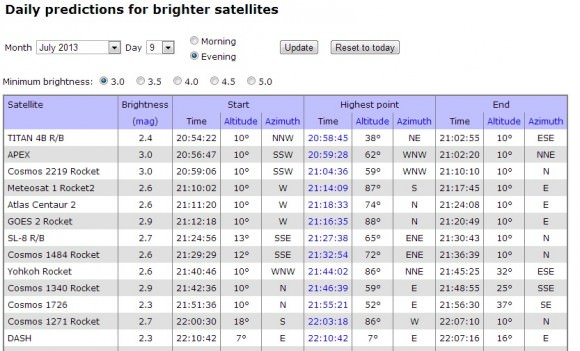
Looking at the time, direction, and brightness of a pass is crucial to satellite identification. No equipment is needed to start the hunt for satellites tonight, just a working set of eyes and information. We sometimes use a set of Canon image-stabilized 15x 45 binoculars to hunt for satellites too faint to see with the naked eye. We’ve seen the “Tool Bag” lost during an ISS EVA a few years back, as well as such “living relics” of the early Space Age as Canada’s first satellite Alloutte-1, and the Vanguards (Yes, they’re STILL up there!) using binocs.
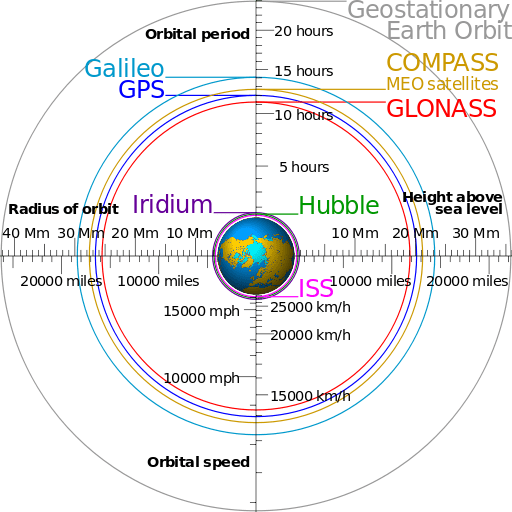
The trick to catching fainter satellites such as these is to “ambush” them. You’ll need to note the precise time that the selected satellite is going to pass near a bright star. Clicking on a selected satellite pass in Heavens-Above will give you a local sky chart with a time-marked path. I use a short wave portable AM radio tuned to WWV out of Fort Collins, Colorado for an accurate audible time signal. Just sit back, listen to the radio call out the time, and watch for the satellite to pass through the field of view near the target star.
Another great site for more advanced trackers is CALSky. Like Heavens-Above, CALSky will give you a customized list for satellite passes over your location. One cool extra feature on CALSky is the ability to set alerts for passes of the ISS near bright planets or transiting the Sun or Moon. These are difficult events to capture, but worth it!
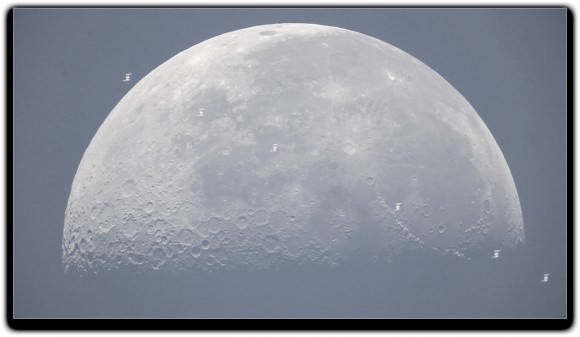
A great deal of what’s up there is space junk in the form of discarded hardware. Many satellites are on looping elliptical orbits, only visible to the naked eye when they are near perigee. Many satellites are located out at geosynchronous or geostationary orbits 35,786 kilometres distant and are invisible to the naked eye all together. These will often show up as streaks in astrophotos. An area notorious for geosynchronous satellites exists near the direction of M42 or Orion Nebula. During certain times of year, satellites can be seen nearby, nodding slowly north to south and back again. Around the March and September equinox seasons, geostationary satellites can be eclipsed by the shadow of the Earth. This can also cause communications difficulties, as many geo-sats also lie sunward as seen from the Earth around these times of year.
Probably one of the simplest satellite trackers for casual users is Space Weather’s Satellite Flybys page. North American users simply need to enter a postal code (worldwide users can track satellites via entering “country-state-city”) and a list of passes for your location is generated.
It’s a basic truism of satellite tracking that “aircraft blink; satellites don’t”. Know, we’re going to present an exception to this rule.
Some satellites will flash rhythmically due to a tumbling motion. This can be pretty dramatic to see. What you’re seeing is an expended booster, a cylinder tumbling due to atmospheric drag end-over-end. Some satellites can flash or flare briefly due to sunlight glinting off of reflective surfaces just right. Hubble, the ISS and the late NanoSail D2 can flare if conditions are just right.
The most dramatic of these are Iridium flares. The Iridium constellation consists of 66 active satellites used for satellite phone coverage in low-Earth orbit. When one of their three refrigerator-sized antennas catch the Sun just right, they can flare up to magnitude -8, or 40 times brighter than Venus. CALSky and Heavens-Above will also predict these events for your location.
Didn’t see a predicted satellite pass? Light pollution or bright twilight skies might be to blame. Keep in mind, passes lower to the horizon also fall prey to atmospheric extinction, as you’re looking through a thicker layer of the air than straight overhead. Some satellites such as the ISS or the USAF’s X-37B spy space plane even periodically boost or modify their orbits, throwing online prediction platforms off for a time.
More advanced satellite trackers will want to check out Celestrak and SAT-Flare Tracker 3D.
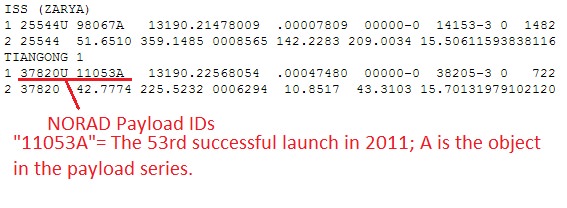
I use a free tracking platform created by Sebastian Stoff known as Orbitron. Orbitron lets you set your observing location and tailor your view for what’s currently over head. You can run simulations and even filter for “visual only” passes, another plus. I also like Orbitron’s ability to run as a stand-alone system in the field, sans Internet connection. Just remember, for it to work properly, you’ll need to periodically update the .txt file containing the Two-Line Element (TLE) sets. TLE’s are data element sets that describe the orbital elements of a satellite. Cut and paste TLEs are available from Heavens-Above and Celestrak.
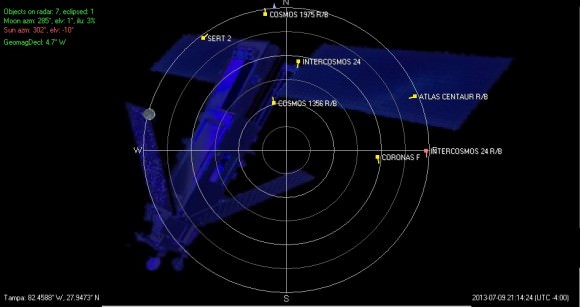
For serious users, NORAD’s Space-Track is the best site for up-to-date TLEs. Space-Track requires a login and user agreement to access, but is available to satellite spotters and educators as a valuable resource. Space-Track also hosts a table of upcoming reentries, as does the Aerospace Corporation’s Center for Orbital & Reentry Debris Studies.
The SeeSat-L mailing list is also an excellent source of discussion among satellite trackers worldwide. Increasingly, this discussion is also moving over to Twitter, which is ideal for following swiftly evolving action in orbit. @Twisst, created by Jaap Meijers,will even Tweet you prior to an ISS pass!
And there’s always something new or strange in the sky for the observant. Satellites such as those used in the Naval Ocean Surveillance System (NOSS) were launched in groups, and are eerie to watch as they move in formations of 2 or 3 across the sky. These are difficult to catch, and all three of our sightings thus far of a NOSS pair have been surreptitious. And we’ve only had the camera ready to swing into action once to nab a NOSS pair;
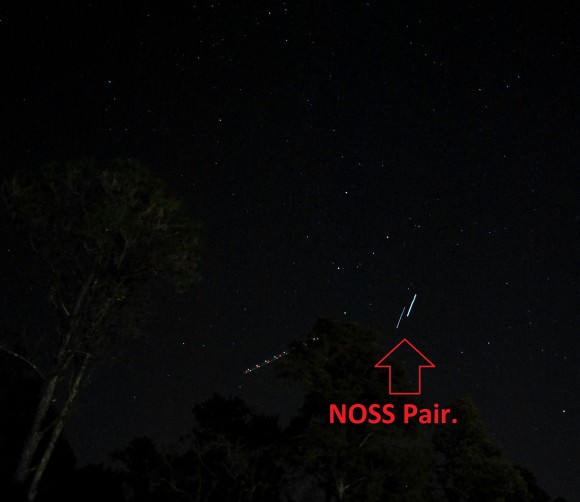
Another bizarre satellite to catch in action is known as the Cloud-Aerosol LiDAR & Infrared Pathfinder Satellite for Observations, or CALIPSO. Part of the “afternoon A-Train” of sun-synchronous Earth observing satellites, you can catch the green LiDAR flashes of CALIPSO from the ground with careful planning, just as Gregg Hendry did in 2008-2009:
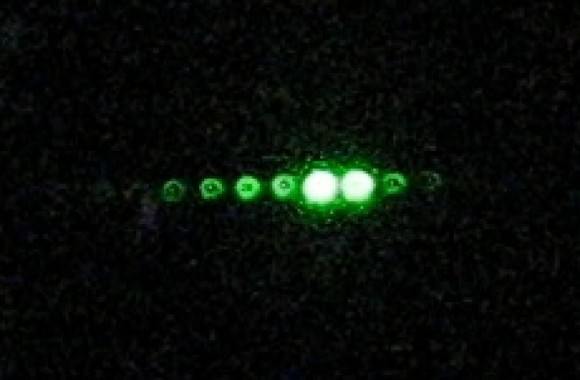
NASA even publishes a prediction table for CALIPSO lidar passes. I wonder how many UFO sightings CALIPSO has generated?
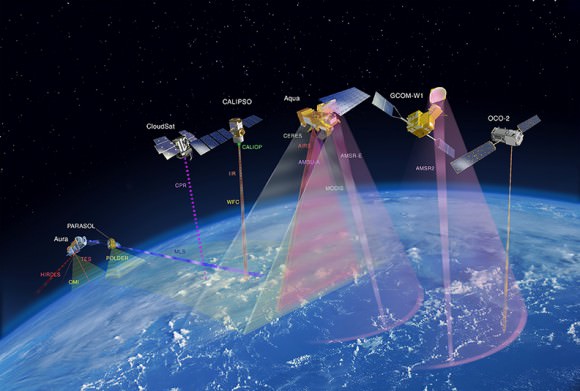
And speaking of photography, it’s easy to catch a bright pass such as the ISS on camera. Shooting a satellite pass with a wide field is similar to shooting star trails; just leave the shutter open for 10-60 seconds with a tripod mounted camera. Modern DSLRs allow you to do several test exposures prior to the pass, to get the ISO, f/stop, and shutter speed calibrated to local sky conditions.
You can even image the ISS through a telescope. Several sophisticated rigs exist to accurately track and image the space station through a scope, or you could use our decidedly low-tech but effective hand-guided method;
And that’s a brief overview of the exciting world of sat-spotting… let us know of your tales of triumph and tragedy as you sleuth out what’s going on overhead!


The best way now-a-days to track an photo or video caputer satellites is:
http://www.optictracker.com/Home.html
Great info in this articail,Many Many things have to come together for the “Perfect’ shot though,(weather,wind,seeing,focus,brightness of pass,angle of pass, etc,etc,…)
It’s hours/days of waiting,how ever long to set-up an about 3 minutes of won’t wait for youTerror on a pass.
Enjoy!
good information, thanks for the sources!!
You’re welcome… I tried to include something for everyone, beginner and experienced satellite hunters alike.
This is one of the nicest page I have been today. Thank you for the information. I have seen some (or same may be) satellites myself with naked eye, however never knew which they were. A handy phone app would be better to track as it is really a possibility that is the only thing you would have to connect and check at most of the times. Do you know of any real good phone applications that we can use to track satellites?
Hmmm… lots out there, including the 3D Satellite Tracker for Android & GoSatWatch for the IPhone…NASA also has an App that includes ISS tracking capability that you might want to check out: http://www.nasa.gov/centers/ames/iphone/